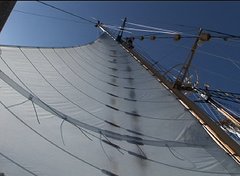 May 19, 2007. Aboard the SSV Robert C. Seamans. Today was sunny and hot here in the tropics. The temperatures are rising. It was 83 degrees near my bunk, which I can attest is not the most comfortable temperature to sleep at. For the first time on this trip, I felt hot.
May 19, 2007. Aboard the SSV Robert C. Seamans. Today was sunny and hot here in the tropics. The temperatures are rising. It was 83 degrees near my bunk, which I can attest is not the most comfortable temperature to sleep at. For the first time on this trip, I felt hot.The day began with strong seas, sails full, and the largest waves of the trip. They're primarily wind-driven and long-period swells. The ship is rolling easily side to side and moving quickly across the top of these waves, sinking into the troughs and rising over the next. Its fun -
somewhat like an amusement park ride, with more roll and lean than any prior day. Speeds as high as 10 knots are helping to make up time from the heavy science stations in the first part of the leg. We're now within 400 nautical miles of our destination, Christmas Island.
Despite the high seas, students are conducting Winkler titrations in the lab, chlorophyll assays, and alkalinity titrations - a testament to the true grit of this program and the Stanford students. You have to hold on a bit more, and use your legs to steady your balance, but after 8 days, we're all experienced at maintaining our balance.
Mindy Summers has conducted her first respiration experiments which is a breakthrough for all of us. She struggled with chief scientists Jeff Schell, Rob Dunbar and Barb Block for three days as they solved software problems for this "first-time" instrument for this trip. As in any science done shipboard, there are often great rewards and challenges and, for Mindy, the disappointment of not having this unique instrument working was palpable. Finally, the microrespirometer is working, and animals such as amphipods, copepods and shrimp from the evening tows are now being placed into miniature chambers and having their metabolic energetics examined.
Kat is looking daily under the Zeiss microscope at the phytoplankton she's been collecting as she examines the species composition along the transect. The members of the turtle team are preparing for their final station now that we're deep into the productive region of the lower latitude frontal station. Satellite images from shore have extremely useful and provide guidance as we select station locations.
We're entering the most productive waters of the trip - the hottest waters - beyond the frontal edge, the region we have yet to see the sea turtles penetrate. My guess is it's just too hot for their reptilian physiology. Large body size, and retention of heat in a 1,700-pound (800 kg) sea turtle would be hard for the turtle to dissipate, and it would overheat. Remarkably, the thermocline (where the water temperature drops rapidly with depth) is shoaling and the oxygen minimum layer is as shallow as 150m. Below this depth, the water is as cold as 8 degrees C and there is less than 1% of the oxygen we have at the surface. This raises a ton of interesting questions that the students are pondering.
Chief scientist Rob Dunbar, Stanford University professor of geology and environmental sciences, gave a fascinating lecture on carbonate production and dissolution in this region of the Pacific, and provided the students with a context for understanding the vertical profiles revealed with the daily noon CTD casts. Related to these observations, Annie Scofield's project involves measuring the pH and alkalinity in samples collected from the deep ocean beneath the ship. She is studying the carbon system in this seldom-sampled part of the planet.
Guest scientist Boris Worm, an assistant professor of marine conservation biology at Dalhousie University in Halifax, Canada, and students have been recording birds daily for Juliann Schamel's project and have had their first sighting of a bird that's native to Kiritimati Island (Christmas Island). That suggests we're getting closer to our Line Island destination. The evening meal was an ono (also known as wahoo) caught on a large lure earlier in the day. -- Barb Block and Rob Dunbar, chief scientists


No comments:
Post a Comment